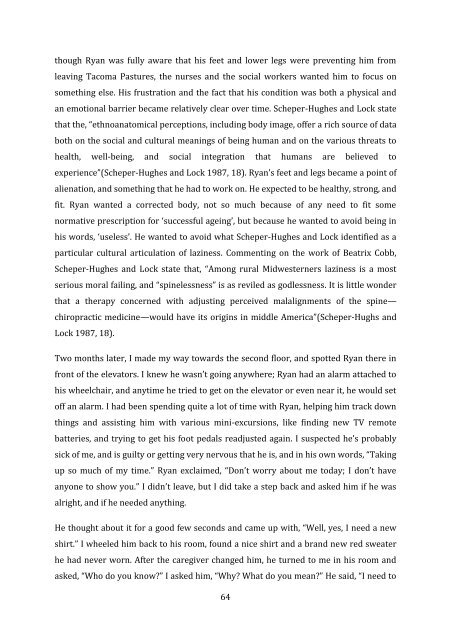Philip Y. Kao PhD thesis - Research@StAndrews:FullText
Philip Y. Kao PhD thesis - Research@StAndrews:FullText
Philip Y. Kao PhD thesis - Research@StAndrews:FullText
You also want an ePaper? Increase the reach of your titles
YUMPU automatically turns print PDFs into web optimized ePapers that Google loves.
though Ryan was fully aware that his feet and lower legs were preventing him from<br />
leaving Tacoma Pastures, the nurses and the social workers wanted him to focus on<br />
something else. His frustration and the fact that his condition was both a physical and<br />
an emotional barrier became relatively clear over time. Scheper-Hughes and Lock state<br />
that the, “ethnoanatomical perceptions, including body image, offer a rich source of data<br />
both on the social and cultural meanings of being human and on the various threats to<br />
health, well-being, and social integration that humans are believed to<br />
experience”(Scheper-Hughes and Lock 1987, 18). Ryan’s feet and legs became a point of<br />
alienation, and something that he had to work on. He expected to be healthy, strong, and<br />
fit. Ryan wanted a corrected body, not so much because of any need to fit some<br />
normative prescription for ‘successful ageing’, but because he wanted to avoid being in<br />
his words, ‘useless’. He wanted to avoid what Scheper-Hughes and Lock identified as a<br />
particular cultural articulation of laziness. Commenting on the work of Beatrix Cobb,<br />
Scheper-Hughes and Lock state that, “Among rural Midwesterners laziness is a most<br />
serious moral failing, and “spinelessness” is as reviled as godlessness. It is little wonder<br />
that a therapy concerned with adjusting perceived malalignments of the spine—<br />
chiropractic medicine—would have its origins in middle America”(Scheper-Hughs and<br />
Lock 1987, 18).<br />
Two months later, I made my way towards the second floor, and spotted Ryan there in<br />
front of the elevators. I knew he wasn’t going anywhere; Ryan had an alarm attached to<br />
his wheelchair, and anytime he tried to get on the elevator or even near it, he would set<br />
off an alarm. I had been spending quite a lot of time with Ryan, helping him track down<br />
things and assisting him with various mini-excursions, like finding new TV remote<br />
batteries, and trying to get his foot pedals readjusted again. I suspected he’s probably<br />
sick of me, and is guilty or getting very nervous that he is, and in his own words, “Taking<br />
up so much of my time.” Ryan exclaimed, “Don’t worry about me today; I don’t have<br />
anyone to show you.” I didn’t leave, but I did take a step back and asked him if he was<br />
alright, and if he needed anything.<br />
He thought about it for a good few seconds and came up with, “Well, yes, I need a new<br />
shirt.” I wheeled him back to his room, found a nice shirt and a brand new red sweater<br />
he had never worn. After the caregiver changed him, he turned to me in his room and<br />
asked, “Who do you know?” I asked him, “Why? What do you mean?” He said, “I need to<br />
64
















